Friend or Foe? How Can You Know?
These are good guys (gals!). They’re the immature stages of the twice-stabbed ladybugs that you may find on crape myrtles. The mature form is glossy black with two orange-red dots on its wings (hence the unflattering common name), but a nymph couldn’t look anything less like the adult.
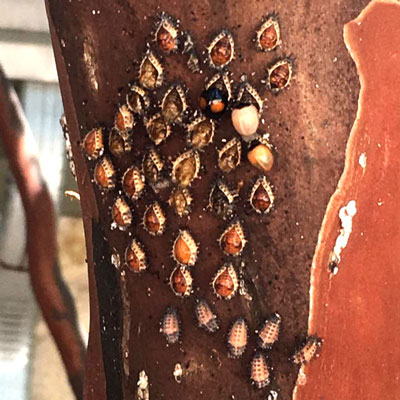
Photo: You can see nymphs of twice-stabbed ladybugs morphing into adult beetles.
Why these ladybugs are so important…
This is where the story gets interesting. (You gotta trust me on this one.)
It was late summer 2004, and someone brought a sample of a crape myrtle stem into a Calloways Nursery on Preston Road in Plano. It had what appeared to be giant mealy bugs attached to it. But when pressed, these insects (obviously some kind of scale) oozed a red fluid, not yellow like so many other scale insects.
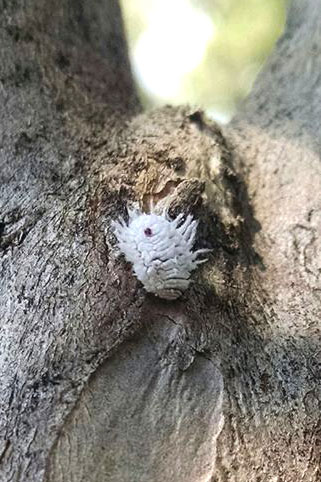
Photo: You can see similarity of this scale insect with mealy bugs. (photo posted by a Facebook friend in 2016)
Jump ahead three years to 2007. We who are interested in crape myrtles were still trying to figure out what the scale might be. That was a very wet spring and early summer, and the scale insect had proliferated seemingly out of control all across the north end of Dallas County and southern portions of Collin County. Yet no one else had ever seen it.
By the end of that season, enough honeydew had been exuded from the scale insects’ bodies that crape myrtles’ leaves and trunks looked like they’d been varnished. Sooty mold fungus lives in the honeydew substrate making the plants look ultimately unsightly. More people express concern over the “black mold” that’s on their plants’ trunks than the presence of the scale insects.
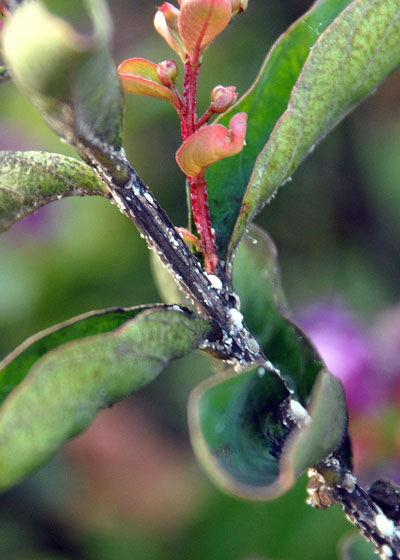
Photo: This was how the scale looked at its worst in 2007.
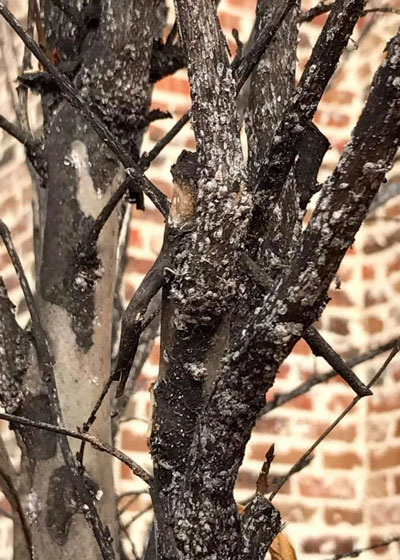
Photo: Facebook friend Karen Z. posted this photo of black sooty mold on stems of her crape myrtle in mid-winter 2016/17. As the trunk expands this old bark sloughs off, taking the sooty mold with it in the process.
Texas A&M entomologists sensed the urgency and began serious research to see if the species could be determined and some type of control identified. Samples were sent to the University of Florida and the Smithsonian, two places where exotic scale insects are studied. I was watching with interest, and I found out how difficult it is to assign species names to scales. I was learning a lot more than I was contributing to be sure.
2007 was the worst year for this scale insect, and that was also the first time a lot of us had seen this particular ladybug. Populations of the nymphs started appearing on the scale-ridden plants, gobbling them up like tiny vacuum cleaners. We in the media were instructed to encourage people not to spray if they saw this insect in good numbers.
In the ensuing 10 years we have seen additional outbreaks of what is now called simply “crape myrtle scale.” However, they have been nothing like that terrible year of 2007. In fact, for most of those last 10 summers the scale outbreaks have been isolated – scattered from plant to plant. A few of those summers we have seen almost no scales at all. But we never know if another serious outbreak could crop up.
At some point a few years ago a group of American horticulturists was visiting China where crape myrtles are native. This scale was observed there, and the theory developed that the scale developed in China and somehow was transported to Richardson, Texas, 13 or 14 years ago. Those things do happen, which is exactly why plant quarantines are in place.
Crape myrtle scales have since spread across East Texas, Arkansas, Tennessee, Mississippi, Alabama and into Florida. Several states and nursery associations have banded together and research is underway to find a reliable solution to this problem.
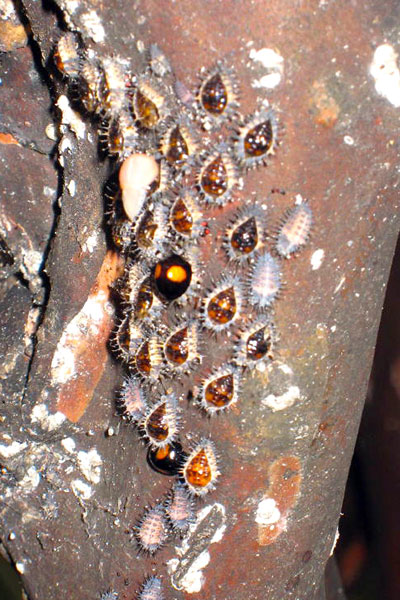
Photo: Nymphs and young adult twice-stabbed ladybugs feed on crape myrtle scales.
If there is any good news to come out of all this, it might be that this particular scale does not seem to do major harm to its host plants. It’s unsightly and disfiguring, but the plants seem to survive the outbreaks, even in serious summers. As the plants start growing the following spring they begin to shed their old bark and the sooty mold is cast off in the process. Meanwhile, populations of the twice-stabbed ladybugs may be growing and waiting. Waiting to step to our plants’ rescue should another bad year pop up anytime soon.
